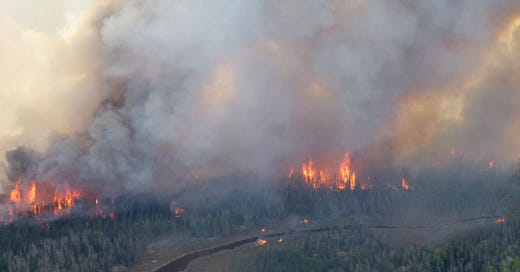Smoke from Canadian wildfires are back
How this may impact your health and what to do about it
As of June 5, 2025, smoke from over 200 active Canadian wildfires—more than 100 of which are out of control—has severely impacted air quality across much of the United States, prompting widespread health alerts and advisories.
U.S. Regions Affected by Canadian Wildfire Smoke
The smoke has drifted southward, affecting air quality in numerous U.S. states:
Midwest: Cities like Chicago, Detroit, Milwaukee, and Omaha have experienced "unhealthy" to "very unhealthy" air quality levels. Chicago's AQI reached 160, ranking it among the worst globally.
Great Lakes & Upper Midwest: Minnesota issued its first-ever maroon air quality alert, indicating extremely hazardous conditions. Parts of Michigan's Upper Peninsula recorded AQI levels exceeding 800.
Northeast: New York City, Boston, and Albany are under air quality alerts due to elevated PM2.5 levels and ozone, exacerbated by summer heat.
Other States: Air quality advisories have been issued in Wisconsin, Indiana, Iowa, New Jersey, Connecticut, Massachusetts, and parts of Maryland.
In total, over a dozen states are under air quality alerts, with smoke visible as far south as Florida.
Health Risks of PM2.5 Exposure
Wildfire smoke contains fine particulate matter (PM2.5), which poses significant health risks. Much of this risk is due to how your immune system interacts with the foreign PM2.5:
Respiratory Issues: Aggravation of asthma, bronchitis, and COPD; increased respiratory infections; and reduced lung function.
Cardiovascular Problems: Elevated risk of heart attacks, strokes, arrhythmias, and heart disease.
Long-Term Effects: Prolonged exposure can lead to lung cancer, impaired lung development in children, and premature death.
Vulnerable populations include children, the elderly, pregnant individuals, immunocompromised people, and other chronic health conditions.
Protective Measures
To safeguard your health during this period:
Monitor Air Quality: Regularly check AirNow.gov for updates.
Stay Indoors: Keep windows and doors closed; use air purifiers with HEPA filters. If you have to drive, keep the windows closed
Limit Outdoor Activities: Avoid strenuous outdoor exercise, especially during high AQI periods.
Use Protective Masks: If necessary to go outside, wear N95 or P100 respirators to filter out harmful particles.
Seek Medical Attention: If experiencing symptoms like coughing, wheezing, or chest pain, consult a healthcare provider. Keep in mind that symptoms do not appear immediately. It may take several days for underlying inflammation to cause symptoms.
Outlook
While some improvement in air quality is expected as weather patterns shift, the wildfire season is anticipated to continue throughout the summer. Staying informed and taking preventive measures remain crucial.
Stay safe and prioritize your health during these challenging times.
Although not required, any support is greatly appreciated.





I know how jaded what I’m about to say will make me sound, but as a resident of Salt Lake, I live in one of the cities with the worst year-round air pollution in the U.S. When I see notices of an AQI in another state of 150-160, my first thought is “that’s not too bad” and then I remember that that shouldn’t be normal anywhere.
It’s definitely getting worse over upstate NY.